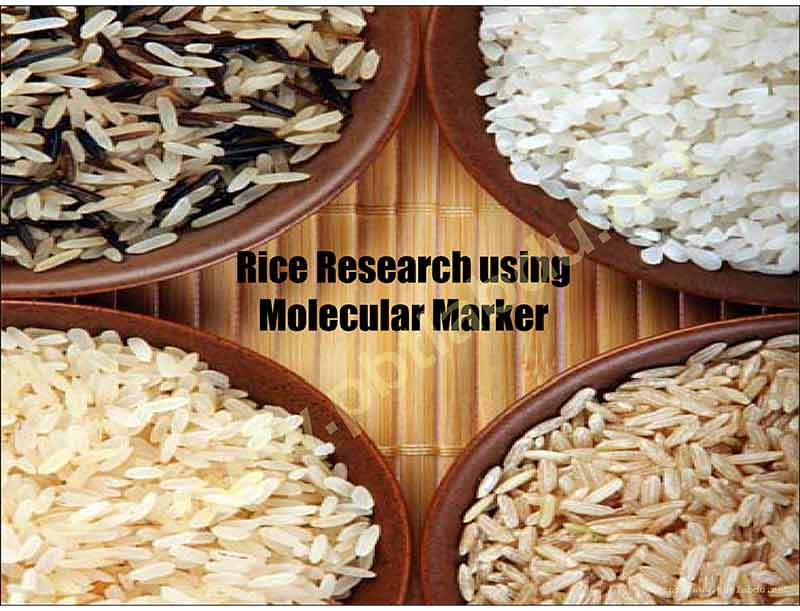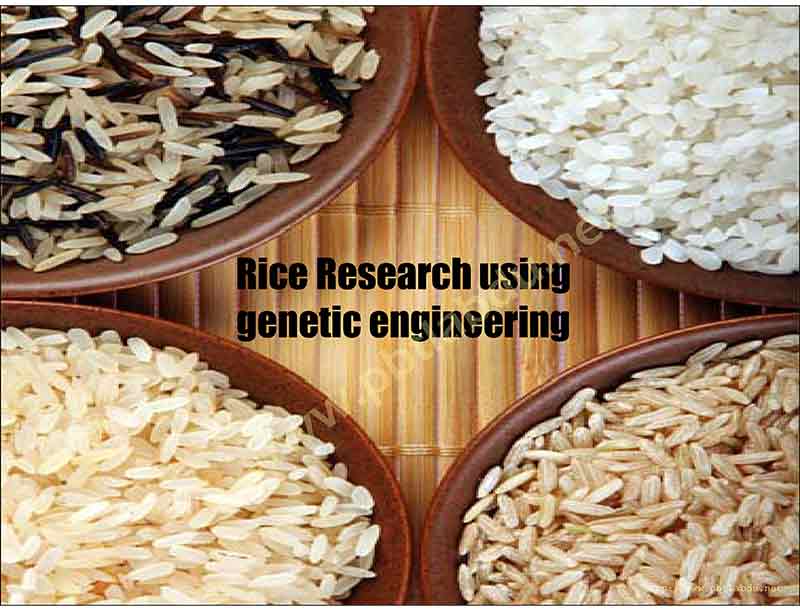Current Activities
The RNA guided CRISPR-Cas9 system has become the method of choice for genome editing because of its simplicity, ease of performing, and versatility. This system exploits the complementary base pairing mechanism of DNA to guide site-specific Cas9 endonuclease to the target site. In our lab, we are using this system for improving the salt tolerance as well as yielding by downregulation of certain genes associated with salt stress e.g. HAK-like, TPK, AKT gene etc.
Plant growth promoting endophytic microbes (PGPFM), such as fungi and bacteria, are known to enhance plant growth both in normal and stressed conditions. Endophyte from host of high salt region can offer salinity tolerance to crops of low salt region So, endophytes of the halophytes from coastal regions were isolated and tested for salt stress tolerance followed by PGP activities screening to study their effects in both normal and salt conditions.
Amelioration of plant growth under stressed condition and plant growth promotion (pgp) of one endophytic fungus drew our attention. This isolate also remarkably improved plant performance at the reproductive stage. Yield increased significantly. Therefore, this isolate is a potential candidate for formulation as a suitable bio-fertilizer to improve rice yield and establish a robust crop variety in regions where the soil is highly saline, such as, in coastal areas. So, this isolate will be subjected for formulation of bio-fertilizer, an apparatus for transporting live microorganisms from laboratory to the field
Halophytes utilize high salt conditions for their benefit but have a wild nature with poor yields and other non-agronomic traits. Oryza coarctata is the only halophyte which sets grain in sea-water (400mM salt) but can’t withstand with our food demands. In our lab, we are trying to transform O. coarctata by Agrobacterium mediated In planta transformation by downregulating genes using CRISPR-cas system.
Several transcriptomics and metabolomics studies has been performed so far for discovering any potential variation associated with salt tolerance. In our lab, transcriptomic study of the tolerant and sensitive population from reciprocal cross of Horkuch and IR29 as well as comparative metabolomics and transcriptomics study of Oryza sativa and halophytic wild rice, Oryza coarctata.
Molecular markers have led to many improvements in the accuracy and functionality of selecting essential traits in breeding for superior crops. However, the discovery of SNP markers and their high through-put detection processes resulted in significant reduction in time and costs in their usage. One of the cheaper and more sensitive methods for SNP detection uses common fluorescent molecules which attach to the tail of primers which amplify SNP-based specific alleles during RT-PCR using real time PCR machines. The name of the process is KASP (Kompetitive/Competitive Allele-Specific PCR). Therefore, the research project adopted under the PBRG sub-project 10 of NATP-2 aimed to establish the widespread application of the KASP method to use SNP markers for efficient rice breeding in Bangladesh.
Production of commercial rice which is also able to grow in saline soils has become necessary in order to meet growing demands for it in the global population. We are exploring whether a nature-based solution involving highly tolerant wild rice and sensitive rice grown in close proximity to observe their physiological and yielding improvement.
This work is in collaboration with the Bangladesh Rice Research Institute (BRRI) as well as IRRI.Marker Assisted Backcrossing (MAB) has been adopted to improve the power and efficiency of breeding programs. MAB approach is the most successful breeding technique for getting desirable genetic gains even over the more complex traits in the shortest possible time, e.g. Swarna Sub1. MAB strategy was therefore under taken to introgress the Saltol QTL into the widely accepted two mega rice varieties BR11 (T. Aman, monsoon) and BR28 (Boro, dry, winter). For Saltol QTL introgression crossing was done with the donor parent FL378, a near isogenic line (NIL) which was derived from Pokkali (a salt tolerant donor variety) and repeated backcrossing was done with high yielding varieties BR11 or BR28.
Salt tolerance is a polygenic trait and is therefore difficult to select by classical techniques. The advent of marker aided selection (MAS) permits rapid and efficient identification of the individuals that contain the genes of interest. A major locus for salinity tolerance trait of the rice landrace, Pokkali, called Saltol has been previously identified on chromosome 1. Thirteen markers from this locus were used to analyze the F6 breeding population between salt tolerant IR60494 and salt sensitive BR29.
The major quantitative trait locus (QTL), Saltol, for seedling-stage salinity tolerance and low Na+/K+ ratio has been previously identified on rice chromosome 1 using recombinant inbred lines (RILs) from the cross of tolerant rice landrace Pokkali and sensitive IR29. A backcross mapping population (BC3F3, BC3F4 and BC3F5 near isogenic lines) derived from a cross of the same parent lines Pokkali and IR29 has been used for the fine mapping of Saltol (continuation of the previous work) and for the investigation of additional QTLs. Salinity tolerance is a multi-trait system. For durable tolerance to salinity, it is necessary to find out other QTLs for salinity tolerance and introgress to farmer popular mega varieties along with the Saltol. This mapping population consisted of a different combination of genotypes i.e. tolerant genotypes (with SES 3-5) with and without the Saltol locus, sensitive genotypes (with SES 6-9) with and without the Saltol locus.
There is a dearth of known donors for salt tolerance traits in rice breeding programs other than Pokkali and Nona Bokra. These landraces are photoperiod sensitive and flower once a year, so that they are poorly compatible with breeding cultivars. Bangladeshi coastal landraces have been found to be biodiverse and salt tolerant accessions are still widely cultivated by farmers. These landraces may be potential donors of salt tolerance traits. One of these coastal varieties, Boilam, is both early maturing as well as photoperiod insensitive and popularly grown as an Aus variety in Noakhali, in the southeast of Bangladesh. Boilam was therefore characterized and analyzed for QTLs linked to salt stress tolerance in a backcross population with a modern Aus variety BRRIdhan27. .
Genetic variation of Oryza sativa L. landraces (LRs) collected from the saline coastal belt of Bangladesh, modern varieties (MVs), as well as Pokkali, Nona Bokra and salt tolerant modern varieties (SMVs) derived from the last two were analyzed with 60 evenly distributed ricemicrosatellite DNAmarkers. A total of 196 reproducible polymorphic alleles were identified from the band loci. Heterozygosity among the 31 LRs was found to be 0.57, 0.46 in the 5 MVs and 0.40 in the 8 SMVs.The microsatellite fingerprinting analysis thus revealed that some of the salt tolerant landraces of the coastal region have unique polymorphic loci, quite distinct from the popular salt tolerance donor Pokkali. The similarity matrices between the O. sativa L. cultivars chosen for the study can be used as a valuable tool for the proper choice of parents for mapping or breeding purposes.
Click here for more
Most Bangladeshi rice varieties are Indica and nonglutinous. However, glutinous rice also exists, for example, Beruin varieties. Glutinous rice produces cohesive grains and are therefore of importance in festivals where the main food item is rice cake. Some of these glutinous rice varieties are red in color. The red pericarp color of rice is of much significance due to its nutritional, evolutionary and domestication history. Glutinous rice contains much higher level of amylopectin compared to nonglutinous rice and high amylopectin is easy for digestion, therefore it has a high glycemic index. This is due to lack of the synthesis of the starch amylose, because of a defect in the gene (waxy) for granule-bound starch synthase.This defect is due to G to T mutation, which causes defective splicing of the gene transcript. A portion of the red pericarp conditioning Rc gene was sequenced and the 14 bp deletion was found in white Bangladeshi varieties under study. In addition, rice microsatellite fingerprinting of Non Glutinous and Glutinous rice varieties with both red and white pericarp were performed for characterization and dissimilarity analysis.
Land races are derived with the knowledge, experience and continuous efforts of our farmers, despite the fact that they do not have any formal scientific training. One such cultivar named Hori dhan was developed by Horipada Kapali, an agrarian farmer of Asannagar, Jhinedah district. This variety was selected from a field, where BR11 and other HYVs were normally cultivated. The publicity regarding this discovery that was created by the print and electronic media raised many questions in the minds of rice growers and scientists. Hori dhan’s similarity to the most popular Bangladeshi rice variety BR11 (Mukta) resulted in a debate on its origin. This work describes a comparative evaluation of the morphogenetic variations between Hori dhan and BR11.
Among the various stresses that impair crop productivity, salinity is a major threat to agriculture. Salinity tolerance is a multigenic trait. Therefore it has been difficult to obtain salt tolerance by using single genes. Many genes are now reported to confer salt tolerance in plants, particularly in the case of dicots like, tobacco. In most of these cases, the genes have been expressed by the constitutive cauliflower mosaic virus promoter (CaMV35S). The same genes with the CaMV35S promoter when transformed into rice do not perform as well because this promoter is not good for monocots such as rice. It can cause yield penalty. Therefore it is necessary to find efficient promoters for rice gene transformation and expression. The promoters of the NHX1 (vacuolar Na+/H+ antiporter) from the salt tolerant landrace Pokkali (PKN) and sensitive cultivar IR-64 (IRN), respectively, were isolated and characterized. Promoter efficiency is generally measured by promoter-reporter gene constructs, used to transform rice
Molecular cloning is widely used as a method to transfer a particular trait to any variety of same or even completely unrelated species. It is also used to over express a gene or a group of genes to change its property like yield or content etc. We are interested to improve the salt tolerance of rice and are therefore cloning several genes in order to transform into farmer popular varieties to improve their acceptability to our local farmers in salt affected areas. The most promising genes reported to improve salt tolerance are for the Vacuolar Sodium/Hydrogen Antiporter, DNA helicase and Glyoxalase pathway. Traditional digestion-ligation methods were bypassed using Gateway technology where insert is transferred primarily to an entry vector.
Salinity is one of the major problems encountered during crop production in Bangladesh. Different transgenic approaches to solve this problem have been reported, but success with rice has been limited. Several genes, shown to confer improved salt tolerance were used for producing transgenic rice. We have transformed the tissue culture-responsive landrace, Binnatoa (BA), with the OsNHX1 constructs containing the 5′ UTR and ORF and also cDNA. OsNHX1 transformed plants showed improved tolerance during seedling salinity screening. The transgenic Binnatoa (BA) has been crossed with farmer-popular dry-season cultivars, BR28 and BR45. The F1 plantlets were selected by RT-PCR, F2 progenies were screened for agronomic properties and F3 plants were taken for salt screening. Half of the F3 plants showed better tolerance than their parents and agronomic properties close to their farmer popular parents. Another gene, the Pea DNA helicase (PDH45), obtained from ICGEB, New Delhi, was also used for transformation. PDH45-transformed T1 BA rice having a single gene insertion showed very good morphology as well as dramatically improved salt stress tolerance at the seedling stage.
Future plans:
- Cloning and rice transformation with genes encoding regulatory molecules such as transcription factors
- Rice transformation with genes driven by salt-inducible promoters.
- Using rice seed-based vaccine delivery systems


